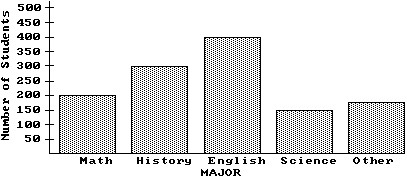Use Bayes' rule to find the indicated probability.The incidence of a certain disease on the island of Tukow is 4%. A new test has been developed to diagnose the disease. Using this test, 91% of those who have the disease test positive while 4% of those who do not have the disease test positive (false positive). If a person tests positive, what is the probability that he or she actually has the disease?
A. 0.438
B. 0.487
C. 0.91
D. 0.856
Answer: B
You might also like to view...
Solve the problem.A $138,000 trust is to be invested in bonds paying 7%, CDs paying 5%, and mortgages paying 9%. The bond and CD investment must equal the mortgage investment. To earn an annual income of $10,180 from the investments, how much should the bank invest in bonds?
A. $26,000 B. $69,000 C. $24,000 D. $43,000
Use the given table or graph to write the inequality described.The bar graph below shows the number of students by major in the College of Arts and Sciences. Use an inequality to compare the number of math and english majors.
Use an inequality to compare the number of math and english majors.
A. 300 < 400 B. 400 > 200 C. 300 > 200 D. 200 > 150
Fill in the blank with one of the words or phrases listed below. Not all choices will be used and some choices may be used more than once. The
The  of a list of terms is the product of all common factors.
of a list of terms is the product of all common factors.
A. difference of two squares B. difference of two cubes C. greatest common factor D. perfect square trinomial
Decide whether the dose is reasonable or unreasonable. If it is unreasonable, indicate whether it is too much or too little.Take 4.1 kg of calcium per day.
A.
| Unreasonable, too little |
B.
| Unreasonable, too much |
C.
| Reasonable |